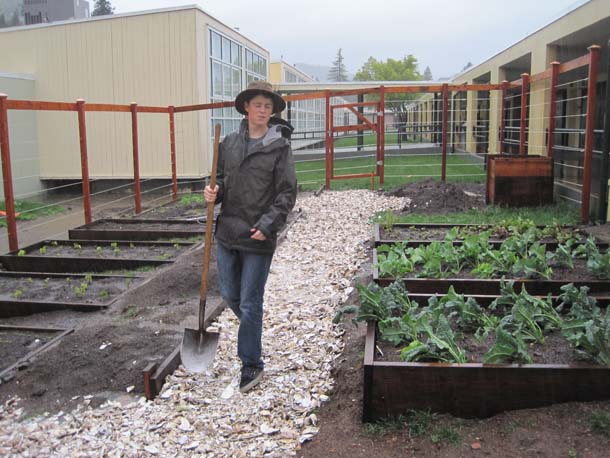On an unseasonably warm morning in January students at Drake High School in San Anselmo relax in a garden just outside their classrooms. Beside them butterflies flutter and tender shoots emerge from dark soil. Three weeks before, this was nothing more than a strip of grass at the end of an architecturally dull corridor.
This garden is the product of a lot more than just the three days it took to build, however. For a decade, garden-loving students dreamed and planned but remained stymied by the complexities of sustaining a student-run garden over time. Then in 2010, students in the school’s newly formed Global Student Embassy club started a new push for a garden; in January 2012, after negotiations went all the way up to the school board, the students finally succeeded.
“I am so inspired by all of the Drake High School students who have taken their garden project from a vision to implementation,” says Kate Crigler, who co-founded the Global Student Embassy Club with her friends Lucas and Jasper Oshun. “There are many teachers and classes that will be incorporating the garden into their curriculum, which is the key to keeping the garden relevant and able to thrive.”
Founded in 2008 and based in Sebastopol, Global Student Embassy now has projects in Northern California, Chile, Peru, Ecuador, Tanzania, and most recently Nicaragua. Nearly every project encompasses organic gardening because the Oshun brothers and the organization believe it is critical for students and youth to understand how food is grown and what importance it has in our lives.
“Gardens are some of the best classrooms for teaching about ecology, methods for producing food and the value of teamwork and community,” says Crigler. “We all need to be connected to where our food comes from–whether that means farming land, or buying directly from the source at farmer’s market.”
After stalling in school politics for more than a year and a half, the Drake project was finally approved in mid-January 2012.
Two weeks later a dozen students showed up along with teachers, parents, and Ecuadorian exchange students and got to work. They carried 60-pound sacks of concrete to the site, unloaded redwood lumber, and tore out the thick sod that had grown in this area for decades.
After a few hours of backbreaking work, the crew had dug 26 holes around the perimeter and eight rectangular squares plots that looked a bit like graves. At the end of the first day the foundation for the garden had been built and what had been a dream started to become a reality.
Two of the high school’s special programs, ROCK (Revolution of Core Knowledge) program and SEA DISC (Studies of the Environment Academy — Drake Integrated Studies Curricula), will use the garden as an outdoor classroom.
“The garden has already provided rare and exciting opportunities for Drake students,” says Sophia Tolbert, a current junior in the SEA DISC academy and GSE member, “and the hope is that the garden will continue to generate positive opportunities for education, agriculture, and community building.”

.jpg)


-300x199.jpg)
-300x199.jpg)
-300x91.jpg)